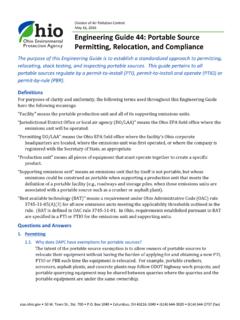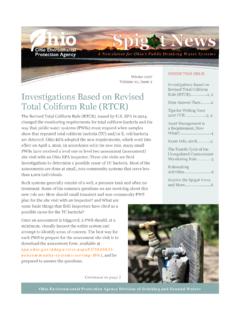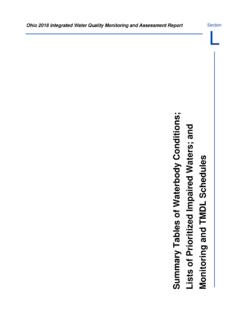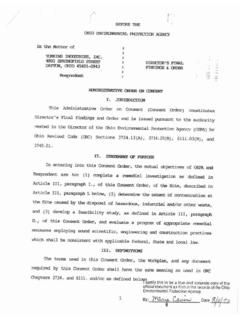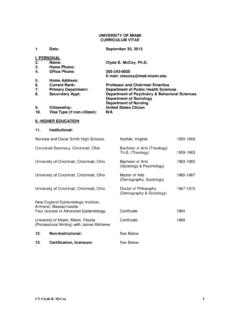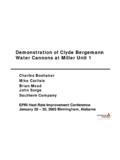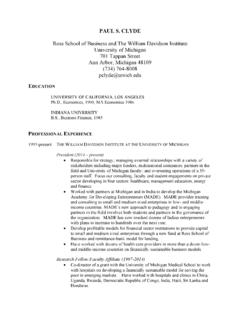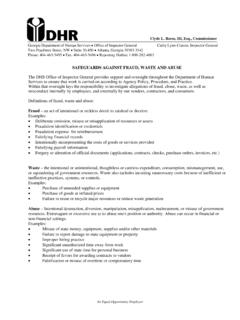Transcription of Drinking Water Quality Sampling to Support the Ohio ...
1 State of Ohio Environmental Protection Agency Division of Drinking and Ground Waters Drinking Water Quality Sampling to Support the Ohio Department of Health Childhood Cancer Investigation, City of clyde and Surrounding Townships April 9, 2009. Governor Ted Strickland Director Chris Korleski [THIS PAGE INTENTIONALLY LEFT BLANK]. Executive Summary Drinking Water Sampling was performed to Support an environmental exposure assessment for a childhood cancer investigation being conducted by the Ohio Department of Health for the City of clyde and surrounding townships. Eleven Drinking Water samples were collected in January and February 2009 from two public Water systems, city of clyde and Northern Ohio Rural Water (NORW), and domestic Water wells. Three samples were collected from the city of clyde public Water system, four samples were collected from NORW public Water system and four domestic Water wells were sampled. The Drinking Water samples were analyzed for a broad scan of carcinogenic and non- carcinogenic chemical compounds.
2 These included inorganic compounds, volatile organic compounds, semi-volatile organic compounds, pesticides/ herbicides, petroleum compounds and radiological parameters. In order to broaden the scope of analysis, a suite of less common organic compounds was requested for analysis. These organic compounds, collectively called tentatively identified compounds (TICs), appear in the results only when their presence is probable, but not absolutely confirmed. The results of the Sampling did not identify any components of Drinking Water that suggest significant carcinogenic health concerns. A few naturally occurring substances were identified at elevated concentrations in the Water well samples. These substances occur naturally in carbonate bedrock aquifers, such as the bedrock aquifer underlying the local area. The naturally occurring substances that exceed a EPA secondary maximum contaminant level (MCL) or health advisory level do not have carcinogenic health implications. Significant findings are as follows: No EPA primary health standard MCL was exceeded for any of the compounds detected.
3 Most values were well below the standard. Strontium was identified at elevated levels (16,600 to 47,700 ppb) in samples collected from the domestic Water wells. One ppb (part per billion) is equivalent to one drop of Water in 50,000 one-liter bottles of Water (13,000 gallons). EPA. has not established an MCL for strontium. EPA s health advisory levels for this substance are 25,000 ppb for children and 4,000 ppb for a lifetime exposure level. Strontium is naturally occurring in the carbonate bedrock aquifer in northwest Ohio. There are no known harmful effects of stable strontium for humans at the levels typically found in the environment. Problems with bone growth may occur in children eating or Drinking unusually high levels of strontium, especially if the diet is low in calcium and protein. Calcium levels in all of the domestic Water wells were higher than the strontium levels detected in the Water in these same wells likely negating the potential adverse health effects from chronic exposures to these elevated strontium levels.
4 I|Page Secondary MCLs (established for cosmetic or aesthetic effects such as taste, odor or color) were exceeded for three substances (iron, sulfate and total dissolved solids) in the domestic Water well samples. This is common for the bedrock carbonate aquifer. A recommended health-based value for sodium (sodium restricted diet) was exceeded in two domestic Water well samples and one NORW sample. Only 11 of the 183 targeted organic compounds were detected (98 percent non- detect, 2013 analyses with 44 detections). This detection frequency is consistent with those found in other Ohio communities. Trihalomethanes (byproducts of the Water disinfection process) were detected in all samples collected at both public Water systems. All detections were below the MCL of 80 ppb which is based on the total trihalomethanes value. Trihalomethane chemicals were not detected in the domestic Water well samples. As part of the screening for organic chemicals, 21 TICs were provisionally identified in one or more of all Water samples.
5 Three compounds were detected at very low concentrations in all sources of Water , two are naturally occurring fatting acids and the other a surfactant. Only 13 values were estimated to be greater than 1 ppb for seven of the provisionally identified compounds. The sporadic distribution and occurrence of these compounds within each of the three sources of Water suggest the actual presence in the Water sample is suspect. These TICs were identified from a library of approximately 160,000 compounds. There is no EPA established primary health standard, secondary standard or health advisory level for any the tentatively identified compounds. Herbicides (atrazine, simazine and Dalapon) and an insecticide (BHC) were detected at low concentrations, all below MCLs, in the public Water system samples which use surface Water as their source of Drinking Water . These chemicals were not detected in the domestic Water well samples. The presence of herbicides in surface Water streams in northwest Ohio is principally associated with agricultural, residential and commercial weed control.
6 To evaluate additional pesticides/herbicides of concern, Ohio EPA will collaborate with the Ohio Department of Agriculture (ODA) to perform additional Drinking Water Sampling during May or June 2009. Gross alpha and gamma radiation were detected only at low activity levels in three of the eleven samples. None of the radiological substances were detected above EPA MCLs. ii | P a g e Table of Contents Introduction .. 1. Local Drinking Water Supplies .. 1. Drinking Water Sample Information .. 1. City of clyde Public Water System .. 1. Northern Ohio Rural Water Public Water 2. Domestic Water Wells .. 2. Selection of Contaminants for Inclusion in the Investigation .. 2. Contaminants in Sources of Drinking 3. Drinking Water Health Standards .. 3. Drinking Water Sample Results .. 4. Inorganic Chemicals .. 4. Organic Chemicals .. 6. Disinfection Byproducts .. 6. Pesticides/Herbicides .. 8. Other Organic Compounds .. 8. Radiological Parameters .. 10. Conclusion .. 11. References .. 13.
7 List of Figures Figure 1 - Naturally Occurring Levels of Strontium in Ohio s Major Water Supply Aquifers ..7. Appendices Appendix 1 - Drinking Water Quality Monitoring Results Appendix 2 - Health Standards Definitions and Water Quality Reporting Units Appendix 3 - List of Compounds Appendix 4 - Additional Information on the Organic Tentatively Identified Compounds . Appendix 5 - Information on Radioactivity Measurements Appendix 6 - Laboratory Results iii | P a g e Introduction Ohio EPA collaborated with the Sandusky County Health Department (SCHD) and the Ohio Department of Health (ODH) to identify potential environmental exposures, in this case the source of Drinking Water , which may help explain the distribution of childhood cancer in the City of clyde and surrounding townships. Children with cancer were using both public and domestic Water sources. To Support the investigation, Drinking Water samples were collected from two public Water systems, city of clyde and Northern Ohio Rural Water (NORW) and domestic Water wells.
8 ODH s initial analyses of the incidence of childhood cancer did not identify clear environmental commonalities among the cancers, so the Drinking Water Sampling could not target specific subsets of parameters for analysis. Rather, the Sampling plan identified a wide range of compounds for analysis to maximize the possibility of identifying potential sources of contamination. This report discusses the results of Drinking Water Sampling conducted in January and February 2009. The report summarizes the following: a description of the local sources of Drinking Water ; an overview of the selection of contaminants included in the investigation; an overview of the typical sources of contaminants that commonly occur in Water ; an explanation of Drinking Water health standards and reporting units; and a detailed explanation of the various detected substances associated with the applicable health standards including a typical source of the contaminant. Local Drinking Water Supplies Three sources of Drinking Water are used in the vicinity of the city of clyde .
9 Two of these sources use surface Water as the source Water ; the clyde public Water system uses Water from Beaver Creek and NORW uses a Water source obtained from the Sandusky Bay via the city of Sandusky Water treatment facility and the Margaretta Water District. The third source of local Drinking Water is ground Water , obtained from Water wells drilled into the limestone bedrock aquifer with well depths ranging from 45 to 100 feet. Drinking Water Sample Information Eleven Drinking Water samples were collected in January and February 2009 from two public Water systems and domestic Water wells. Three samples were collected from the city of clyde public Water system, four samples were collected from the NORW public Water system and four domestic Water wells were sampled. Ohio EPA staff collected the Drinking Water samples in cooperation with staff from SCHD, city of clyde and NORW public Water system as well as local residents. Ohio EPA s Division of Environmental Services performed all laboratory analyses, except for the radiological parameters, which was completed by the ODH laboratory.
10 City of clyde Public Water System Number of Samples: 3. Sample Locations: Water treatment plant tap and distribution system (near middle school, south end of town). Source of Water : Beaver Creek to two upland reservoirs 1|Page Northern Ohio Rural Water -NW Public Water System Number of Samples: 4. Sample Locations: Entry point (master meter) to distribution system, three in the distribution system: east of clyde ; south of clyde ;. and west of clyde . Source of Water : Purchased Water from Erie County Margaretta District public Water system, which buys from city of Sandusky. Original source of Water is Lake Erie/Sandusky Bay. Domestic Water Wells Number of Samples: 4. Sample Locations: Homes of study participants. Source of Water : Bedrock carbonate aquifer, most wells are 45 to 100 feet deep. Selection of Contaminants for Inclusion in the Investigation Ohio EPA collaborated with ODH on the selection of a comprehensive set of chemicals that may be associated with cancers. The Agency also evaluated commercial and industrial usage of chemicals in the city of clyde , as well as the type of chemicals that are included as part of the ground Water monitoring program for the hazardous waste underground injection facility in Vickery, OH.


